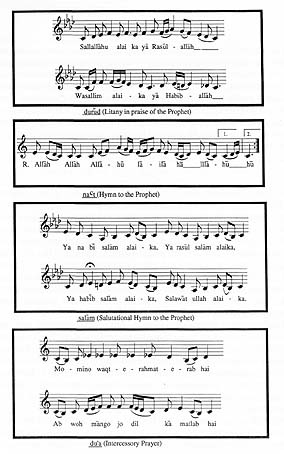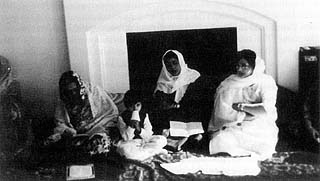| • | • | • |
Milad
Milad is the devotional assembly in the most traditional sense, celebrating the Prophet’s birth on the twelfth day of the month Rabi ul-Awwal. Practiced by Muslims all over South Asia, the milad has an established format. A small reciting group presents a sequence of chanted[11] hymns in praise of the Prophet (na‘t), alternating with spoken homilies (riwayat,bayan) and interspersed with Arabic praise litanies (durud). Like all religious events, a milad begins with God, often in the form of a hymn of praise to God (hamd); sometimes it is preceded by qur’anic recitation. A salutational hymn to the Prophet (salam) followed by an intercessory prayer to God (du‘a) and a recitation of al-Fatiha (sura 1), the sura dedicated to prayer for the dead, conclude the event (fig. 11).

Figure 11. Hymns recited at Milad-e-Akbar: Durud (litany in praise of the Prophet); Na‘t (“Allah Allah Allahu”); Salam (“Ya Nabi Salam Alaika”); and Du‘a.
Milads are held during the entire month of Rabi ul-Awwal and also on auspicious occasions such as a move into a new house, professional success, and family events such as the arrival of a daughter-in-law from Pakistan or the birth of a healthy grandchild. Milads are predominantly a women’s tradition, and even in South Asia, they take place mainly in homes, with women reciting.[12] In Canada, the smaller Muslim community of the 1960s and 1970s saw milads that included both women and men and their then mostly small children.
One of many such events from the late 1970s stands out in my memory, a milad held in conjunction with a bismillah celebration, a ceremony that initiates a child’s education, traditionally at the age of four years and four months. The milad was organized to precede the brief ceremony as an expression of praise and thanks, and to invoke blessings. The ceremony itself bespeaks the centrality of reading and reciting the qur’anic word: a religious teacher or family elder guides the child’s hand to write the first letters of the Arabic Urdu alphabet and recites with her the opening words of the Qur’an: “Bismillah al-rahman al-rahim” (“In the name of God, the all-compassionate, the all-merciful”).
As friends gradually arrived, they were invited to settle down in the living- and dining-room area, which was cleared of furniture and covered with white sheets, back support being offered by pillows and bolsters, as well as by the walls. A special carpet was placed against one wall for the reciters. An attractive cloth packet containing the book Milad-e-Akbar (Akbar Warsi n.d.), a compilation of hymns and prose sermons from which recitations would be chosen, was placed on a decorative raised pillow. The guests sat down along the other walls, eventually forming a loose circle around the entire area. Men and women naturally chose to sit in different areas of the s-shaped space, joining friends among their gender group and talking informally. The hostess had previously asked a friend who was a competent reciter for the recitation, and the latter then asked two other invited friends to join her. The milad was relatively short, with only two sets of hymns and riwayat, followed by the salam and then the du‘a.
Then the bismillah ceremony followed, all conducted by the women, with the men participating as listeners. Everyone’s attention was on the beautifully dressed little girl and her words of recitation. The joyous event concluded with a sumptuous dinner.
Today, preference has shifted to all-female milads, supported by the trend noted above toward separating social space by gender. Excluding men also allows the hostess to include participants from twice as many households, which is socially desirable given the expanding personal circles brought about by the larger numbers of immigrants. These events are now multigenerational. Overall, the recitation may lack the performative creativity of the seasoned semiprofessionals of the Indian subcontinent. But, as in a recent “housewarming” milad where the grandmother of the young hostess presided over four generations (fig. 12), milads often do achieve an intensely religious mood in a setting of relaxed intimacy.

Figure 12. Recitation of the great-grandmother. Photograph by Yasmeen Nizam.